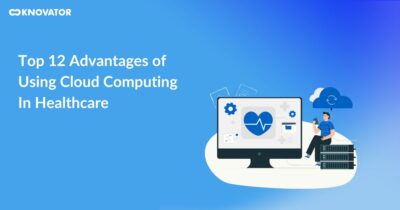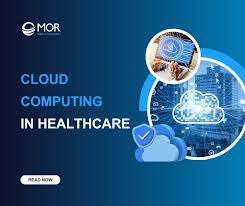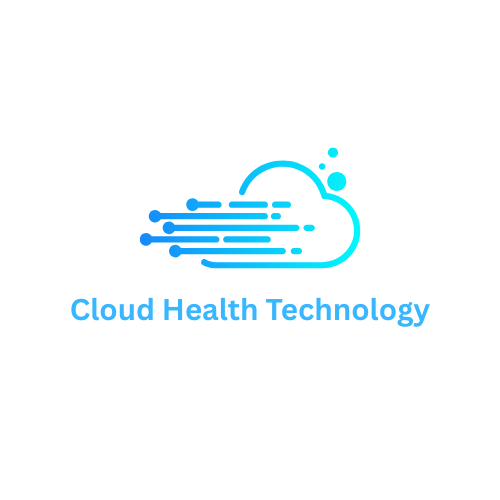Revolutionizing Care
Have you ever been so anxious about losing a medical report that you thought it was your phone? Imagine a world in which your medical records are safely saved in the cloud and are available whenever you need them, just like your favorite Netflix series. This is becoming a reality thanks to cloud health technology, which is making healthcare quicker, safer, and more widely available. According to a 2023 study, 83% of healthcare providers currently use cloud-based systems to optimize operations, and Grand View Research projects that the global market will grow to $64 billion by 2027.
This technology is revolutionary, whether you’re a senior monitoring heart medication or a tech-savvy millennial scheduling a virtual checkup. With a dash of humor (because healthcare could use a good laugh), we’ll examine practical applications, discuss the top benefits of cloud health technology, and take a look at its promising future in this post. Are you prepared to discover how the cloud is improving our health? Let’s get started!
What Is Cloud Health Technology?
Cloud health technology, which uses cloud computing to store, manage, and process medical data, is similar to a digital superhero for the healthcare industry. Imagine a huge, safe virtual filing cabinet that is available from any location with an internet connection and contains everything from your most recent prescription to your X-ray results. It drives wearable technology, telemedicine platforms, electronic health records (EHRs), and even AI-driven diagnostics, all of which are housed on distant servers.
This technology makes healthcare more seamless than a sunny day by ensuring that physicians, patients, and even smartwatches are in agreement. Cloud health technology offers convenience and connectivity for people of all ages, whether they are Gen Zer’s managing mental health apps, boomers monitoring cholesterol, or children with asthma plans.
Why is this important? It facilitates real-time data sharing and gets rid of the mess caused by paper records. Before you can say “stethoscope,” a hospital in New York can send a patient’s file to a specialist in London. It is also secure, scalable, and getting cheaper, which benefits everyone—from urban health systems to rural clinics.
Fun fact: According to Statista, the cloud healthcare market is expanding at a rate of 12% annually, demonstrating that it is not merely a fad but rather the way of the future.
Read more: 5 benefits of cloud computing
Key Benefits of Cloud Health Technology
Enhanced Data Accessibility
Ever tried finding a medical record in a stack of papers? It’s like searching for a needle in a haystack while blindfolded. Cloud health technology solves this by storing patient data in a centralized, digital platform accessible anytime, anywhere. For a teenager managing diabetes, this means checking insulin logs on a phone app. For a grandparent with arthritis, it’s pulling up medication history at a new doctor’s office. In emergencies, paramedics can instantly access allergies or past surgeries, potentially saving lives.
For people of all ages:
While younger people appreciate the convenience of mobile apps, seniors appreciate how simple it is to access chronic condition records.
Real-time updates:
By updating records instantly, doctors can prevent mistakes like prescribing the incorrect medication.
Worldwide access:
Are you going overseas? Your data, safely kept in the cloud, travels with you.
Both patients and providers benefit from this accessibility. To get the most out of these resources, see our guide on how to use health apps safely.
Improved Patient Care
Using cloud health technology gives your doctor superpowers, such as the ability to work together and take action more quickly. Experts can instantly exchange data stored in the cloud, guaranteeing precise diagnosis and customized care. For instance, a Chicago cardiologist can consult with a Sydney neurologist to review an MRI without sending a CD. Cloud-powered telemedicine enables patients to consult doctors from the comfort of their own homes, making it ideal for seniors with limited mobility, working parents, and people living in remote areas.
-
Personalized care: AI analyzes cloud data to suggest treatments, like adjusting meds for a heart patient.
-
Remote monitoring: Wearables track vitals, alerting doctors to issues like irregular heartbeats before they escalate.
-
Patient empowerment: Apps let you monitor everything from blood sugar to sleep, giving you control.
Telehealth is a huge part of this. Our post on telehealth trends for 2025 dives deeper into its rise.
Cost Efficiency
Cloud health technology lessens the impact of healthcare expenses, which can be more painful than an unexpected dental bill. According to McKinsey, hospitals can reduce administrative expenses by as much as 30% by digitizing their records. Predictive analytics helps avoid expensive readmissions to hospitals, and automation lowers the need for staffing. Additionally, patients save money because telemedicine eliminates travel costs and cloud-based systems share existing data, reducing the need for costly tests.
|
Cost-Saving Aspect |
Impact |
|---|---|
|
Reduced paperwork |
Saves 20–30% on admin costs |
|
Telemedicine |
Cuts travel and consultation fees |
|
Predictive analytics |
Reduces readmissions by 15% |
|
No on-site servers |
Lowers IT costs for clinics |
It benefits both big hospitals and small clinics, lowering the cost of care for people of all ages. Check out this Forbes article on cloud adoption to learn more about the savings.
Scalability for Everyone
From small clinics to large hospital networks, cloud health technology is the universal solution for healthcare technology. Affordable cloud plans are a good place for startups to start, and as they expand, they can add storage. Millions of records are handled by large hospitals without experiencing any issues. This scalability levels the playing field for patients of all ages by guaranteeing that rural patients receive the same advanced medical care as city dwellers.
-
Flexible storage: Add capacity as patient numbers grow, no new hardware needed.
-
Quick upgrades: New features roll out instantly, keeping systems current.
-
Universal access: Remote areas tap into cutting-edge tech via the cloud.
Curious how clinics scale? Our guide to healthcare scalability breaks it down.
Robust Security Measures
Concerned about hackers accessing your medical records? Digital Fort Knox is analogous to cloud health technology. Your information is more secure than your mother’s recipe for lasagna thanks to encryption, multi-factor authentication, and HIPAA-compliant protocols. Regular audits and backups protect against crashes or cyberattacks, giving peace of mind to everyone from privacy-conscious millennials to cautious boomers.
-
Data encryption: Secures records during storage and transfer.
-
Regular backups: Prevents data loss from tech failures or attacks.
-
Compliance: Meets strict standards like HIPAA and GDPR.
For more on compliance, check out Health I T. gov’s HIPAA guide.
Streamlined Collaboration
Healthcare becomes a team sport thanks to cloud health technology. No matter where they are, specialists, nurses, and doctors can access and update patient data instantly. Without making countless phone calls, picture a pediatrician, allergist, and dietitian collaborating on a child’s asthma treatment plan. From children with allergies to elderly people with complicated conditions, this partnership enhances results for all ages.
-
Shared platforms: Multiple providers view the same data, reducing miscommunication.
-
Instant updates: Changes sync instantly, keeping everyone in the loop.
-
Global teamwork: International specialists collaborate on rare cases.
This teamwork is a lifesaver—literally. Explore more in our healthcare collaboration guide.

Support for Innovation
Advanced technologies like artificial intelligence and machine learning are facilitated by cloud health technology. In order to forecast illnesses, suggest therapies, or even identify trends in public health, such as flu outbreaks, these examine enormous datasets. Whether it’s a retiree receiving AI-powered cancer screenings or a teenager receiving insights into their mental health, this translates into smarter care for patients.
-
AI diagnostics: Spots issues like tumors faster than humans.
-
Predictive analytics: Forecasts health risks, like diabetes complications.
-
Research boost: Scientists share cloud data for faster drug development.
Read more: Six Advantages of Cloud Computing
Real-World Applications
Cloud health technology is already saving lives, so it’s not just futuristic hype. Wearable technology, such as Apple Watches, monitors heart rates and notifies users of any abnormalities by syncing with cloud platforms. Cloud-based AI is used by hospitals to forecast outbreaks, assisting communities in getting ready. For busy parents or elderly people living in rural areas, telehealth platforms such as Teladoc facilitate the connection between patients and physicians.
-
Wearables: Track fitness or chronic conditions in real time.
-
Public health: Cloud data predicts and manages disease outbreaks.
-
Telemedicine: Virtual visits save time and improve access.
Case study: A Chicago hospital used cloud EHRs to reduce patient wait times by 35%, improving care for all ages. Learn more in our health tech examples post.
Challenges and Solutions
Cloud health technology has its peculiarities, and no technology is flawless. Nobody wants their medical history to be available on the dark web, so data security is crucial. End-to-end encryption and frequent audits are two solutions that reduce risks. Rural connectivity problems can be frustrating, but offline syncing and satellite internet are helping to bridge the gap. Additionally, user adoption can be challenging, particularly for older adults, but it is made simpler by user-friendly apps and tutorials.
-
Challenge: Data breaches.
-
Solution: Advanced encryption and staff training.
-
-
Challenge: Poor internet access.
-
Solution: Offline modes and satellite connectivity.
-
-
Challenge: Tech resistance.
-
Solution: User-friendly interfaces and support resources.
-
For deeper insights, read Gartner’s cloud security guide.
Future of Cloud Health Tech
Cloud health technology has a more promising future than a disco ball at a dance party. As AI advances, it will be able to anticipate illnesses before symptoms manifest. From children with anxiety to elderly people with chronic pain, virtual reality may provide immersive therapy sessions. Blockchain could be incorporated, adding additional security measures. This translates into more accessible, individualized care for people of all ages—imagine customized treatment plans sent directly to your phone.
-
AI advancements: Predicts health risks with scary accuracy.
-
VR therapy: Immersive mental health support via the cloud.
-
Blockchain security: Next-level protection for sensitive data.
Stay ahead with our 2025 health tech predictions.
Case Studies
Let’s get real with some success stories:
-
Rural Texas Clinic: A small clinic implemented cloud-based EHRs, cutting patient wait times by 40% and improving care for elderly patients with chronic illnesses.
-
Global Research Network: Scientists used cloud platforms to share COVID-19 data, speeding up vaccine development by months.
-
Telehealth in Action: A California provider used cloud-powered telemedicine to serve 10,000+ patients monthly, from teens to seniors, saving millions in travel costs.
These examples show how cloud health technology delivers tangible benefits across the board.
How to Get Started
Ready to embrace cloud health technology? Here’s how patients and providers can jump in:
-
For patients: Download a cloud-based health app like MyChart to track records or book virtual visits. Start small—check your latest lab results online.
-
For providers: Partner with cloud vendors like Epic or Cerner for EHR systems. Train staff to ensure smooth adoption.
-
For all: Prioritize security—use strong passwords and enable two-factor authentication.
Need help choosing tools? Our health tech starter guide has you covered.

Summary
Cloud health technology is revolutionizing healthcare by increasing its efficiency, security, and accessibility for people of all ages. It functions similarly to a digital doctor in your pocket, offering immediate data access, cost savings, scalability, and AI-driven innovation. Solutions like encryption and offline modes keep things moving forward in spite of obstacles like security threats or connectivity problems. Applications in the real world, such as telemedicine, wearable technology, and outbreak forecasting, are already making people’s lives better. Cloud health technology is poised to further transform healthcare in an era of AI, VR, and blockchain. Are you prepared to embrace the revolution in health tech? Leave a comment with your thoughts!
Read more: New home decor from John Doerson
FAQs
1. What is cloud health technology?
Cloud health technology uses cloud computing to store and manage healthcare data, like EHRs and telemedicine platforms. It’s secure, accessible, and connects doctors and patients seamlessly, improving care for all ages.
2. How secure is cloud health technology?
It’s locked down with encryption, multi-factor authentication, and HIPAA compliance. Regular audits and backups keep data safer than a bank vault, ensuring privacy for everyone.
3. Can cloud health tech save money?
Absolutely! It cuts paperwork by 20–30%, reduces readmissions, and saves travel costs via telemedicine. Both patients and providers benefit, making care more affordable across all ages.
4. Who benefits from cloud health technology?
Everyone! Kids get better asthma care, seniors track chronic conditions, and millennials love telehealth. Clinics and hospitals scale easily, delivering top-notch care to all.
5. What’s the future of cloud health tech?
Think AI predicting diseases, VR for therapy, and blockchain for security. Cloud health technology will make care more personalized and accessible, transforming health for every generation.

